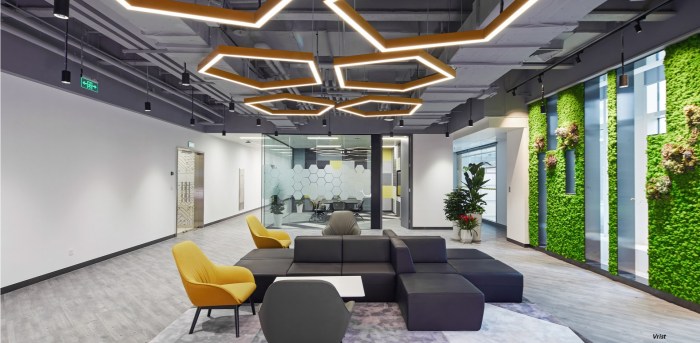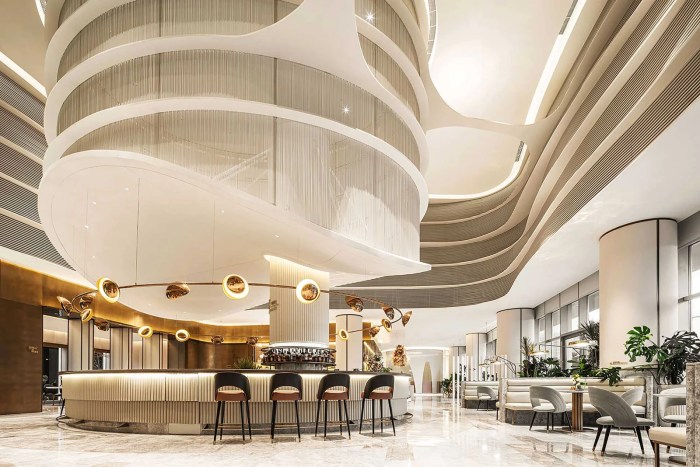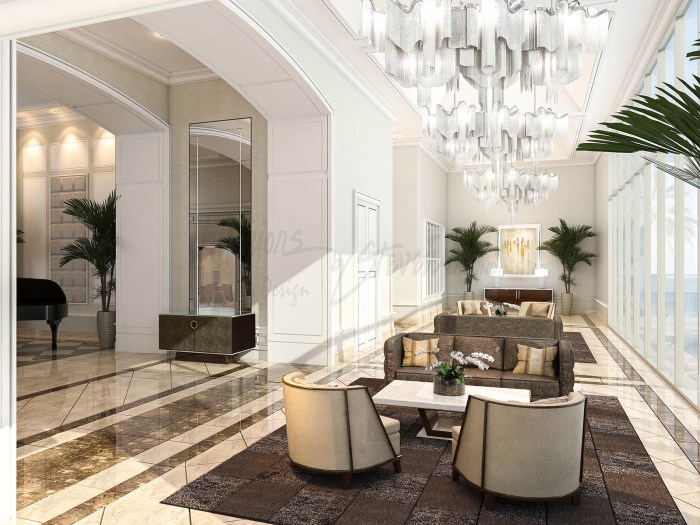Crafting Exceptional Commercial Interior Design: Key Elements, Trends, and Challenges

Embark on a journey through the world of commercial interior design, where creativity meets functionality to transform spaces into captivating experiences for businesses and visitors alike. From innovative trends to common challenges, this topic delves into the core aspects that shape modern commercial spaces.
As we explore the importance of well-designed commercial interiors, the significance of elements like lighting, color schemes, and furniture layout becomes clear, influencing not just aesthetics but the overall success of businesses.
Importance of Commercial Interior Design

Commercial interior design plays a crucial role in creating inviting and functional spaces that can have a significant impact on businesses. A well-designed interior not only enhances the overall aesthetics but also influences the mood and behavior of employees, customers, and visitors.
Enhancing Brand Image
One of the key aspects of commercial interior design is aligning the space with the brand identity. By incorporating brand colors, logos, and values into the design, businesses can create a cohesive and memorable brand experience for customers.
Boosting Productivity
Effective interior design can improve employee productivity by creating a comfortable and inspiring work environment. Factors such as natural lighting, ergonomic furniture, and well-organized spaces can positively impact employee morale and efficiency.
Increasing Customer Engagement
Well-designed commercial spaces can attract more customers and encourage them to stay longer. By creating a welcoming atmosphere and optimizing the layout for easy navigation, businesses can enhance the overall customer experience and increase sales.
Successful Commercial Interior Design Projects
- The Apple Store: Known for its minimalist and sleek design, Apple stores worldwide offer a unique and immersive shopping experience that reflects the brand's innovative and modern image.
- Google Headquarters: Google's office spaces are designed to promote creativity and collaboration, with vibrant colors, open layouts, and recreational areas that inspire employees to think outside the box.
- Starbucks Coffee Shops: Starbucks locations are designed to evoke a cozy and inviting atmosphere, with comfortable seating, warm lighting, and a consistent design aesthetic that reinforces the brand's commitment to quality and community.
Elements of Commercial Interior Design
Commercial interior design encompasses various elements that come together to create a cohesive and functional space. From lighting to color schemes, each component plays a crucial role in shaping the overall look and feel of a commercial environment.
Key Elements of a Well-Designed Commercial Space
- Effective Lighting: Proper lighting can enhance the mood, ambiance, and functionality of a space. It can also highlight key areas or features within a commercial setting.
- Strategic Color Schemes: The choice of colors can influence emotions, perceptions, and behaviors of individuals in a commercial space. A well-thought-out color scheme can create a welcoming and professional atmosphere.
- Functional Furniture Layout: Furniture placement is essential for optimizing the flow and usability of a commercial space. It should be arranged in a way that promotes productivity and comfort for employees and visitors alike.
Importance of Lighting, Color Schemes, and Furniture Layout
- Lighting: Proper lighting can impact the overall ambiance, visibility, and energy efficiency of a commercial space. It can also affect the mood and productivity of individuals working or visiting the area.
- Color Schemes: Colors have the power to evoke specific emotions and perceptions. Choosing the right color palette for a commercial interior can help create a cohesive and inviting environment that resonates with the brand identity.
- Furniture Layout: The arrangement of furniture in a commercial space can influence the flow of movement, collaboration among employees, and overall comfort. A well-planned layout can maximize space usage and enhance the functionality of the area.
Textures and Materials in Design Aesthetic
Textures and materials play a significant role in adding depth, visual interest, and character to a commercial interior design. From sleek and modern finishes to warm and natural elements, the choice of textures and materials can contribute to the overall aesthetic appeal of a space.
Trends in Commercial Interior Design

In the ever-evolving world of commercial interior design, staying up-to-date with the latest trends is crucial to creating innovative and functional spaces that meet the needs of businesses and employees alike.
Sustainability and Eco-Friendly Designs
One of the most prominent trends in commercial interior design is the emphasis on sustainability and eco-friendly designs. Companies are increasingly looking to reduce their carbon footprint and create environmentally conscious workspaces
Technology in Modern Commercial Interior Design
Technology plays a significant role in shaping modern commercial interior design. From smart building systems to interactive workspaces, technology is revolutionizing the way businesses operate. Features like touchless controls, digital signage, and virtual meeting rooms are becoming standard in commercial spaces, enhancing productivity and efficiency.
Challenges in Commercial Interior Design
Interior designers working on commercial projects often face various challenges that can impact the design process and final outcome. From budget constraints to space limitations, navigating these obstacles requires creativity and strategic thinking.
Budget Constraints Impacting Design Choices
Budget constraints are a common challenge in commercial interior design projects. Designers must find ways to create innovative and appealing spaces while staying within the allocated budget. This can sometimes limit the choice of materials, finishes, and furniture, requiring designers to be resourceful and creative in their approach.
Strategies such as prioritizing key design elements, sourcing cost-effective alternatives, and negotiating with suppliers can help overcome budget limitations.
Overcoming Space Limitations
Space limitations are another significant challenge in commercial interior design. Designers often have to work with existing floor plans and structures, which can restrict the layout and functionality of the space. To overcome this challenge, designers can explore creative solutions such as multi-functional furniture, strategic zoning, and innovative storage solutions.
Maximizing natural light, using reflective surfaces, and incorporating vertical elements can also help create the illusion of more space in compact commercial settings.
Importance of Functionality in Commercial Spaces
Functionality plays a crucial role in commercial interior design as it directly impacts the efficiency and productivity of a space. By focusing on how a space functions, designers can create environments that not only look visually appealing but also support the needs of the users.
Enhanced User Experience
- Efficient layout: A well-designed layout that considers the flow of traffic and ease of movement can enhance the overall user experience in a commercial setting.
- Optimized workspaces: Functionality in design can lead to optimized workspaces that promote collaboration, productivity, and employee satisfaction.
- Incorporating technology: Integrating technology seamlessly into the design can improve efficiency and make tasks easier for users.
Aesthetics vs. Functionality
- Balance is key: While aesthetics are important in commercial design, striking a balance between visual appeal and functionality is crucial to ensure a space meets the practical needs of its users.
- Multipurpose spaces: Designing spaces that can serve multiple functions without compromising on usability showcases the importance of functionality in commercial interior design.
- Flexibility: Creating flexible layouts and furniture arrangements allows for adaptability in commercial spaces, catering to changing needs and preferences.
Final Wrap-Up

In conclusion, commercial interior design is a dynamic field that constantly evolves to meet the changing needs of businesses and consumers. By balancing functionality with aesthetics, embracing trends, and overcoming challenges, designers create spaces that inspire and elevate the human experience.
FAQ Overview
How does interior design impact businesses?
Interior design can significantly influence customer perception, employee productivity, and brand identity, ultimately impacting the success of a business.
What are some current trends in commercial interior design?
Current trends include biophilic design, flexible workspaces, and sustainable materials to create healthier and more environmentally friendly environments.
How do designers overcome budget constraints in commercial projects?
Designers often prioritize key elements and materials, explore cost-effective solutions, and collaborate with clients to find creative ways to stay within budget.
Why is functionality important in commercial interior design?
Functionality ensures that spaces are practical and efficient, enhancing user experience and maximizing the potential of a commercial environment.

